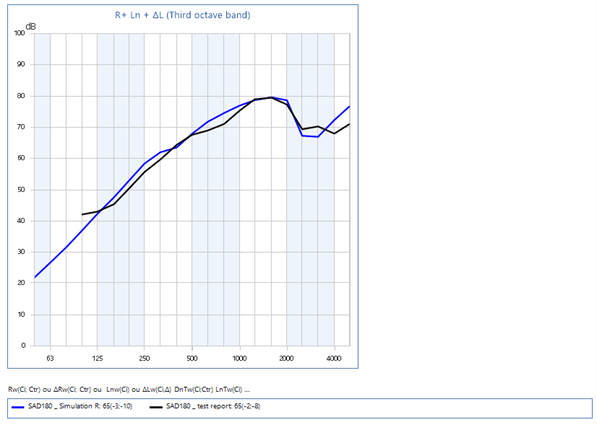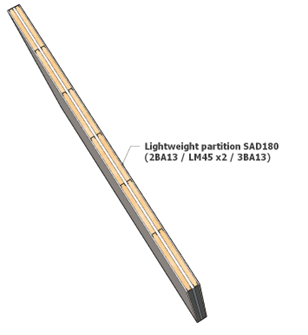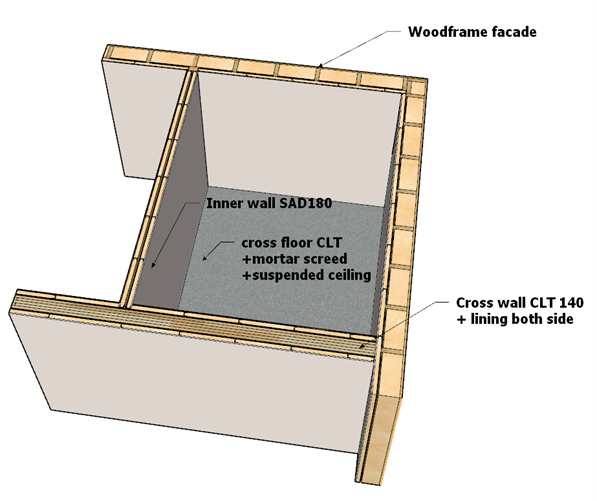Home › Software development › AcouS STICS21®
Home › Software development › AcouS STICS21®
AcouS STICS21® ® is a software package for calculating airborne sound insulation and impact sound insulation between rooms. Our software is based on the calculation methods of the ISO 12354 series of standards and calculates the acoustic magnitudes DnT,W (C; CTr) and L'nT,W (CI; CI50-2500) in compliance with the ISO 717 and ISO 10140 standards. It integrates simulations from AcouS STIFF® et AcouS STING®.
In addition to our tutorials, our development teams can train you in the use of AcouS STICS21® .
AcouS STICS21® is designed for construction professionals who need to comply with statutory or programme-specific acoustic requirements in terms of sound insulation against interior airborne noise and impact noise for all types of premises (housing, offices, health or education establishments, etc.) and for many types of constructive systems (concrete, masonry, CLT, wood frame, etc.).
Our software is based on the calculation methods of the ISO 12354 series of standards and calculates the acoustic quantities DnT,W (C; CTr) and L'nT,W (CI; CI50-2500) in accordance with ISO 717. It can be used to integrate simulations from the AcouS STIFF® et AcouS STING®.
Le logiciel AcouS STICS21® software is an ergonomic and adapted tool that allows :
It is therefore possible to display simultaneously and in detail the performances of the various structures which compose the premises being analysed to assess their performances and their influences on the overall insulation results sought.
AcouS STICS21® is the latest module to complete the AcouS STIFF® et AcouS STING®These programmes are used to simulate sound reduction and impact noise, and have been tested and validated by a considerable number of licensees for several decades in France and in other countries. AcouS STICS21® allows the simulation results of AcouS STIFF® et AcouS STING® to be integrated into the calculation of the insulation between premises of many construction complexes (concrete/heavy/wood frame/LCT floors, suspended ceilings, brick or block facades, lined or unlined, partitions, wood frame walls, etc.). In AcouS STICS21®, users can also integrate their own data from laboratory or in situ measurements (R, Ln, ΔR, ΔL, Kij, Dvij,n, Dne, Dnf, …).
TheAcouS STICS21® calculation model is based on the approach of the ISO 12354 series of standards, and of all the latest studies and R&D developments of the GAMBA group.
The AcouS STICS21® calculation model is based on the approach of the ISO 12354 series of standards, and of all the latest studies and R&D developments of the GAMBA group.
The calculation situation is taken from the ADIVBOISstudy, configurations S13-03 / S14-04 in the ADIVBOIS mock-up report from 08-03-2022.
The calculation process
Compositions of the components
The floor is a CLT panel with a thickness of 140 mm. It is lined underside by a suspended ceiling composed of 2 x 12.5mm plasterboards (BA13) with 80 mm of mineral wool + 20 mm of air space in the plenum. A 50 mm mortar screed coating on a thin 3 mm thick acoustic underlayer is laid on the floor. The acoustic underlayer is consisting of a glass fibre layer surfaced with a bituminous binder and a plastic film, and has an impact noise improvement ΔLW = 19 dB mesured on a heavy floor.
Acoustic performances calculated with AcouS STIFF® and AcouS STING®: RW + C = 64 dB ; Ln,W = 55 dB ; Ln,W + Ci50-2500 = 56 dB
A calculation/measurement comparison of the sound transmission index and the impact noise level of the floor is presented below :


The façade is composed of a wooden frame with external bracing in CTBH 12mm + 20 mm stability plate, a 145 mm mineral wool insulation between the upright and an interior lining composed of 2 x BA13 plasterboards + 45 mm mineral wool on a metal frame independent of the wooden frame façade.
Acoustic performance calculated with AcouS STIFF® (without external cladding): RW + C = 65 dB
A calculation / measurement comparison of the sound transmission index of the wood frame façade is presented below :


The cross wall are composed of a 140 mm CLT panel lined on both sides by an independent lining on a metal frame composed of 2 x BA13 plasterboards + 45 mm mineral wool.
Acoustic performance calculated with AcouS STIFF®: RW + C = 58 dB
A comparison of the calculation / measurement of the sound attenuation index of a 94 mm CLT lined on one side by a 2xBA13 plasterboards + 45 mm of mineral wool complex on a metal studs is presented below :


The lightweight partition is a twin frame independent SAD 180 type composed of a facing with 2 BA13 plasterboards + 45 mm mineral wool on a metal studs and another facing with 3 x BA13 plasterboards + 45 mm mineral wool on a metal studs.
Acoustic performance calculated with AcouS STIFF®: RW + C = 62 dB
A calculation/measurement comparison of the sound transmission index of the SAD180 partition is presented below :


Junctions between components :
During the ADIVBOIS study, measurements of the vibration reduction index Kij have been carried out. AcouS STICS21st® software allows, among other, the user to enter his own acoustic performances of junctions. Thus, for the present case study, the Kij measured on the mock up for each junction are considered. The Kij used in the calculation, taken from the ADIVBOIS study, are presented below :

The configuration of the premises :
The calculation was carried out for two rooms superimposed as follows.


The calculation/measurement of global insulation indexes are presented below :

The overall value of the calculated airborne noise insulation is 1 dB below the measured value and the curves follow each other over the entire spectrum.

The overall values L’nT,W et L’nT,W + Ci50-2500 of calculated impact noise levels are 1 dB below the measured values. The curves intersect at around 500 Hz with differences that can be explained by the modelling of the whole CLT floor complex by AcouS STING®.
This course is designed for design engineers responsible for recommending building systems, technical sales staff responsible for specifying a structure derived from a catalog system, and R&D engineers responsible for developing a wall, assembly system or manufacturing technology.
For all our software, a complete range of products and services is at your disposal :
This maintenance contract provides among other things : the maintenance of the software and the dongle, the delivery of software updates for free for holders of the maintenance contract, phone support, special discounts on other software
Each year a new version containing additions or changes in the software is available.
We regularly organize inter-company and intra-company training courses on the use of the software.
Each year and each software program, at least one day of information and discussion is held with the users of such software.
We can do calculations of acoustic simulations on request with the use of our software. You can avail of these services free or at very favorable terms for an annual fee.
For more information, please contact us
You will find below answers to some questions you ask and which we hope will give you the information you seek.
Yes, the integration of a false ceiling or technical floor is possible. An adaptation of the laboratory measurement to the in-situ characteristics (dimensions, plenum height, presence of absorbent, etc.) is carried out via a dialog box. There is no particular module for he integration of an ancoustic barrier, but the data (test) of a continuous ceiling with an acoustic barrier can be fully integrated.
The junctions database is the calculation of the KIJ and DVJ according to the junction resulting from the annexes of the 12354 standard, you will find the same values as if you make the calculations with the standard. They will be embellished according to the junctions that we will have characterized on certain assemblies.
The partitions are simulated from AcouS STIFF® (there is a specific partition module being finalized) or you can integrate a test report.
We can start from 0, if you have data you can enter everything in experimental value. It will be necessary to provide certain additional information on acoustic performance (mass, type of facing, etc.)
It is possible to integrate a facade Dnf (wooden frame or curtain wall for example) in horizontal or vertical configuration.
Yes, you can have a partition in a plasterboard partition attached to a concrete facade and with a concrete floor or curtain wall characterized by the DnF and even in absolute terms have a different concrete floor at the emission and at the reception. You can have a different floor covering on emission and reception, etc., each facing is characterized separately.
For the moment no, it is under development
Yes, just drag and drop if you want to compare all the DnTs with all the walls concerned, the same for the L'nT.
The blue is for the ground and the white for the sky in relation to the horizontal and vertical section of the premises to have a representation of the offsets.
Yes, subject to having the data. You can integrate Kij or Dvij,n manufacturer or that you have measured.
All the junctions that you see appearing in the STICS21® database are junctions from the latest version of the standard.
The test report is filled in via a window, then you fill in the values and you integrate them into the DnF experimental values icon. Finally, by double clicking on the experimental value, the window for adapting the laboratory test to the in-situ characteristic opens.
For airborne noise yes, integrated via the test report. For the impact sound we are under development.
Yes they are integrated into AcouS STICS21®.
A calculation/measurement comparison battery was carried out to validate the models from in-situ measurements for AcouS STICS21® and from laboratory measurements for AcouS STIFF®/STING®.
The software works like a database, you can create an “.sia” file (AcouS STIFF®/STING®/STICS21® format), once the file is created it is compatible with other files. When you make a new project (new “.sia” file), you can copy-paste your simulations or test report from one “.sia” file to another. There is therefore no need to re-enter the data.
Yes, an EXCEL or OPEN OFFICE import is possible, the import format is provided with the delivery of the software.
The orders of magnitude of the uncertainties are identical to those of standard EN 12354 and depend on the input data.
Yes, they are given in formation. We invite you to consult the 12345 standard to see more details on this. You can access these data in the software by displaying the values of Kij/Dvij,n or Dvij on the graphs/results table.
We made comparisons on several calculation models, we found some slight differences due to the input data (R and Ln in particular), as a general rule, we have the same overall results. We have validated our software whether by measurement, calculation formula or other software.
Yes, we validated by comparisons of calculations/measurements. The orders of magnitude of the uncertainties are identical to those of standard EN 12354 and depend on the input data.
It is not possible to use AcouS STICS21® without AcouS STIFF®/STING®. With the software suite, predefined fixtures (= pre-calibrated simulations allowing extrapolations) and a materials database are provided.
Materials: concrete, asphalt, natural wood, reconstituted wood Solid brick, textile fibers, plant fibers, fiber cements, wood wool, rock wool, glass wool, metals, closed pore foams, open pore foams, polymer plastics, plaster , Rockwool. They are covered during our training.
No it is not configurable. It is standardized at Tr=0.5 seconds as for the majority of the objectives defined by the regulations. If you want, you can export the results and apply a reverb duration fix to it.
To integrate a door into STICS21, you need to enter an insert. To do this :
You can also contact us directly by telephone on 05.62.24.36.76